
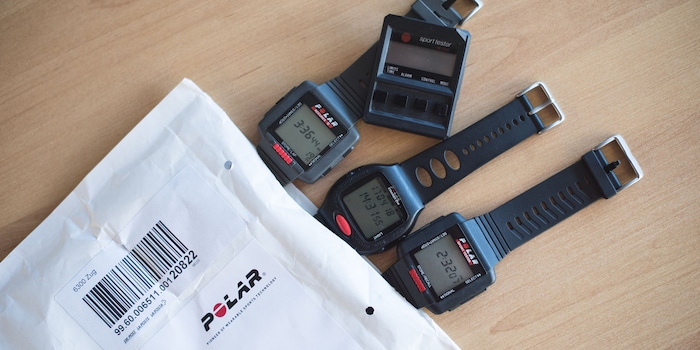
Polar: The forefather of the heart rate monitor in retrospect
We are looking for you. Andrea Jacob and Dominik Bärlocher have unravelled the history of the Polar heart rate monitor and suddenly realised that they had taken on a historic mission.
Every smartwatch has a heart rate monitor built in. Some better, some worse. But ask in a digitec shop or in any sports shop for the most accurate heart rate monitor, and the answer will most likely be "Polar". Polar were the first to bring the heart rate monitor to the wrist, and they are still at the top. But it's quiet around the brand. No big PR campaigns, no launch events, hardly any advertising outside of specialist magazines. Their new devices just turn up, without much fanfare, and athletes still believe in them and buy enough to justify this strategy. So why not save on marketing?
Andrea Jacob, Category Marketing Manager, slams an envelope on my desk. The Polar logo above the label. My name underneath. Why does Andrea have this envelope? My emotional state is somewhere between disinterested and confused. What does she want from me now?
"What am I supposed to do with it," I ask.
"Open up now," she says. Somehow she's much more excited about the envelope than I am.
Okay, I'll do it then. Ancient Polar watches.
"Good, what?"
Andrea is still more enthusiastic than me. I look at her questioningly.
"We're now comparing the old devices with the latest tracker," she says.
Okay, that could be good. After all, if a tracker accurately measured your heart rate x years ago, why innovate? Just so that people buy a new model every year and then feel better?
The test devices from antiquity
Andrea has put her heart and soul into it. She asked Polar Switzerland about the old devices, where they dug through the archives and brought old devices to light. However, as the packaging and operating instructions are no longer available, we have to research what kind of devices they are and when they came onto the market. Fortunately, the website Polars is packed with documentation. The user manuals for pretty much every device are archived there. Sometimes the scans aren't the best, but everything is readable.

- Polar Sport Tester PE200 from 1986
- Polar Sport Tester PE4000 from 1989
- Polar Accurex II from 1992
- Polar XTrainer Plus from 1996
While we're at it, let's take a look at the history of the manufacturer.
Polar sets the tone
Polar is something like the forefather of all smartwatches as we know them today. Not because it invented the concept of smartwatches, but because of an idea: Polar wanted to invent a wearable and accurate heart rate monitor. The fact that pretty much every smartwatch has a heart rate monitor built in can be directly attributed to this idea. However, who ultimately brought the world's first smart smartwatch onto the market is still a matter of debate. The comments column is sure to chime in here and make suggestions.
Before the Polar company launched its first heart rate monitor with the resounding name "Sport Tester PE 2000" - everything was 2000 back then, it seems - in 1982, there was an idea. This was created in 1977. Really Finnish. On a cross-country ski trail. Until the early 1980s, cross-country skiers and other endurance athletes had the problem of not being able to measure their pulse during training. Sure, the technology to measure the pulse existed, but it was complicated. Runners had to get on a treadmill, get wired up and then run. Cross-country runners didn't stand a chance, as nobody came up with the admittedly somewhat original idea of inventing a cross-country treadmill on which a wired athlete could run in the lab.
After the idea was born, things moved quickly. In the same year, the young company managed to build a wearable heart rate monitor. As a proof of concept that said "Yes, it is possible with the technology of 1977".
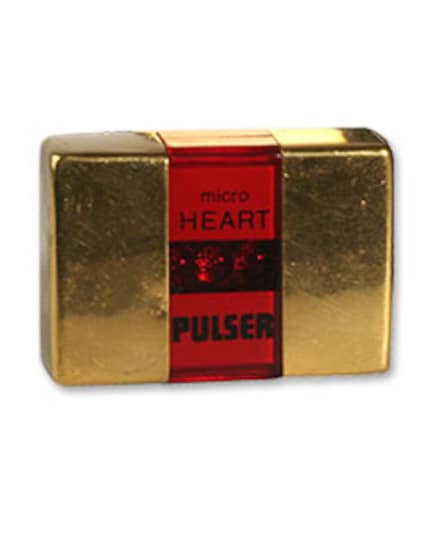
The Micro Pulser proved that pulse can be measured without a cable
One year later, the device developed at the University of Oulu was launched on the market as the Tunturi Pulser
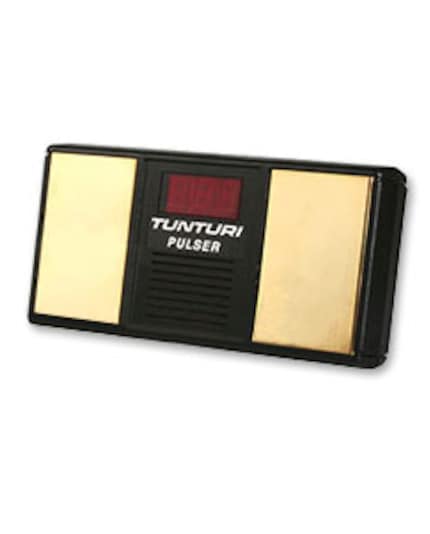
One year later, the launch of the Tunturi Pulser
The first step had been taken. The heart rate monitor was wearable. However, it was still impractical for athletes, because suppose a cross-country skier wanted to measure their pulse during training. He would have to stop, use the box and then write down the pulse. Polar's aim, however, was for an athlete to be able to do this during training. As an aside, without losing focus on the sport and training.
In 1982, this was achieved. And because there was just enough space for a display, Polar also built in a watch.
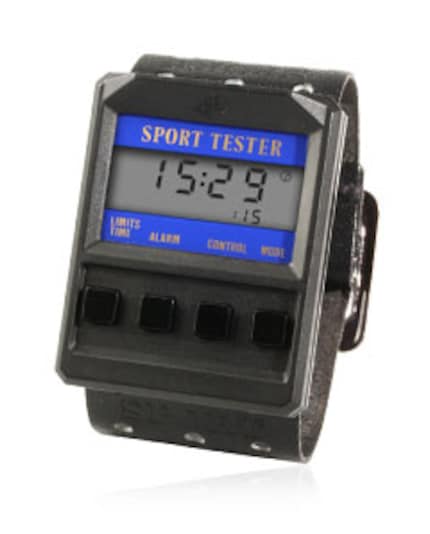
Polar's first coup: The Sport Tester PE2000
From then on, things moved quickly. Polar had proven that it was possible to measure your heart rate during training. Not only athletes are interested, but also cardiologists who want to observe things like cardiac arrhythmias outside of laboratory conditions
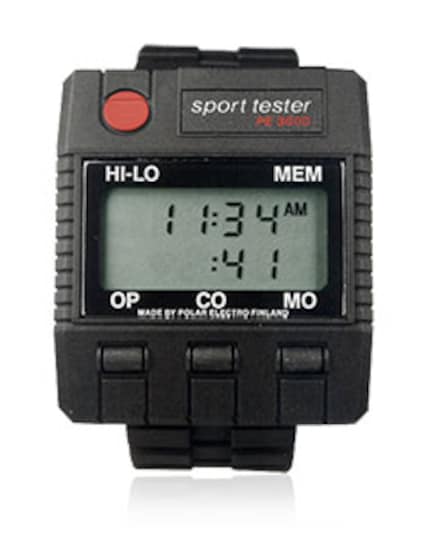
The successor: The PE3000
Polar's original devices have become rarities. Polar Switzerland doesn't have a PE2000 lying around, nor do we know where outside of Polar's headquarters in Finland such a thing could even be lying around and on Ebay the PE3000 is sold for a horrendous price.
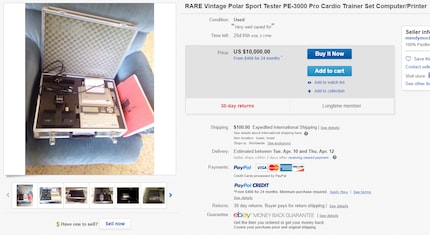
In the 1980s and 1990s, Polar became synonymous with the term "watch for athletes". The reputation still resonates today.
And today?
Polar has not stopped developing. A feature here, some software upgrades there, better batteries, more power. The heart rate monitor - still the company's flagship product - can be worn either as a chest strap, on the wrist or as a sensor array on the skin.
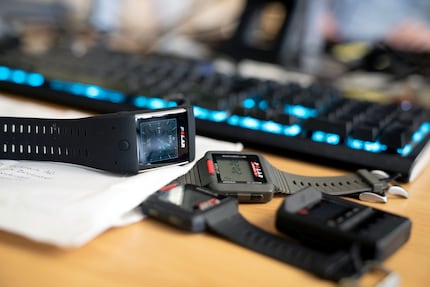
The Polar M600 is currently the flagship model from the Finns. Now that we have the old watches and the flagship next to each other, it makes sense to compare them. After all, if the heart rate was measured accurately back then, why has Polar continued to develop over the years? It wouldn't be necessary, would it?
The M600 has little in common with its predecessors. It is slightly heavier and much bulkier than the Accurex II. However, the screen has remained roughly the same size, probably because human wrists can only be so big. However, the screen of the M600 is full-colour and can be operated by touch.
All the sensors are built into the M600 itself, whereas the Accurex II and the other devices have no obvious sensors at all. The part that rests on the skin is simply a metal plate. The M600 has the charging port and the heart rate monitor array at the bottom, where your skin touches the watch.

It quickly becomes apparent that the M600 is not just for athletes, but also for everyday people with a slightly sprained taste. The people who wear hiking boots and corduroy trousers to the office and generally go all Reinhold Messner on us. The jogging gods in spandex and cyclists in partially stuffed spandex. Where the Accurex II and the Xtrainer Plus still look like digital watches from film and television, with the exception of the striking red button, the M600 has a futuristic look. It is a real piece of work. Because even if the display is small, the watch case is quite bulky and inflexible.
In comparison with devices from the pre-smartphone era, the Polar M600 generally performs better. Only not in terms of battery life. After around two days, the M600 becomes a useless and unattractive bracelet, while the Accurex II thinks it's 20 February 1992 - a Thursday, by the way - and happily continues to show numbers on the display.
Other than that, however, the M600 has far more to offer with just over 20 years of development. A full-colour display, no more need for a chest strap, even if it can be paired with the watch, and a wide range of functions that you would expect from any smartwatch. In short: the M600 has the accuracy in heart rate measurement that you can expect from Polar, and all the features that you have come to expect from a smartwatch.
Wear OS, the newly named Android Wear, should only be mentioned in passing, because expecting sophisticated software from a device from the 1980s or 1990s would be a little presumptuous. The M600 has software, the old devices barely do.
Documentation is missing
Andrea and I conclude our excursion into the history of the wearable wrist-based heart rate monitor. We have noticed one thing above all. The history of Polar, especially the look at the products themselves, apart from company history, has somehow gone under.
So here's a call to you: Do you have any vintage Polar watches at home that we could borrow for a text and/or video? In particular, we are looking for the Polar Sport Tester PE2000 and its successor, the PE3000.
If so, then please get in touch with us.
Journalist. Author. Hacker. A storyteller searching for boundaries, secrets and taboos – putting the world to paper. Not because I can but because I can’t not.
